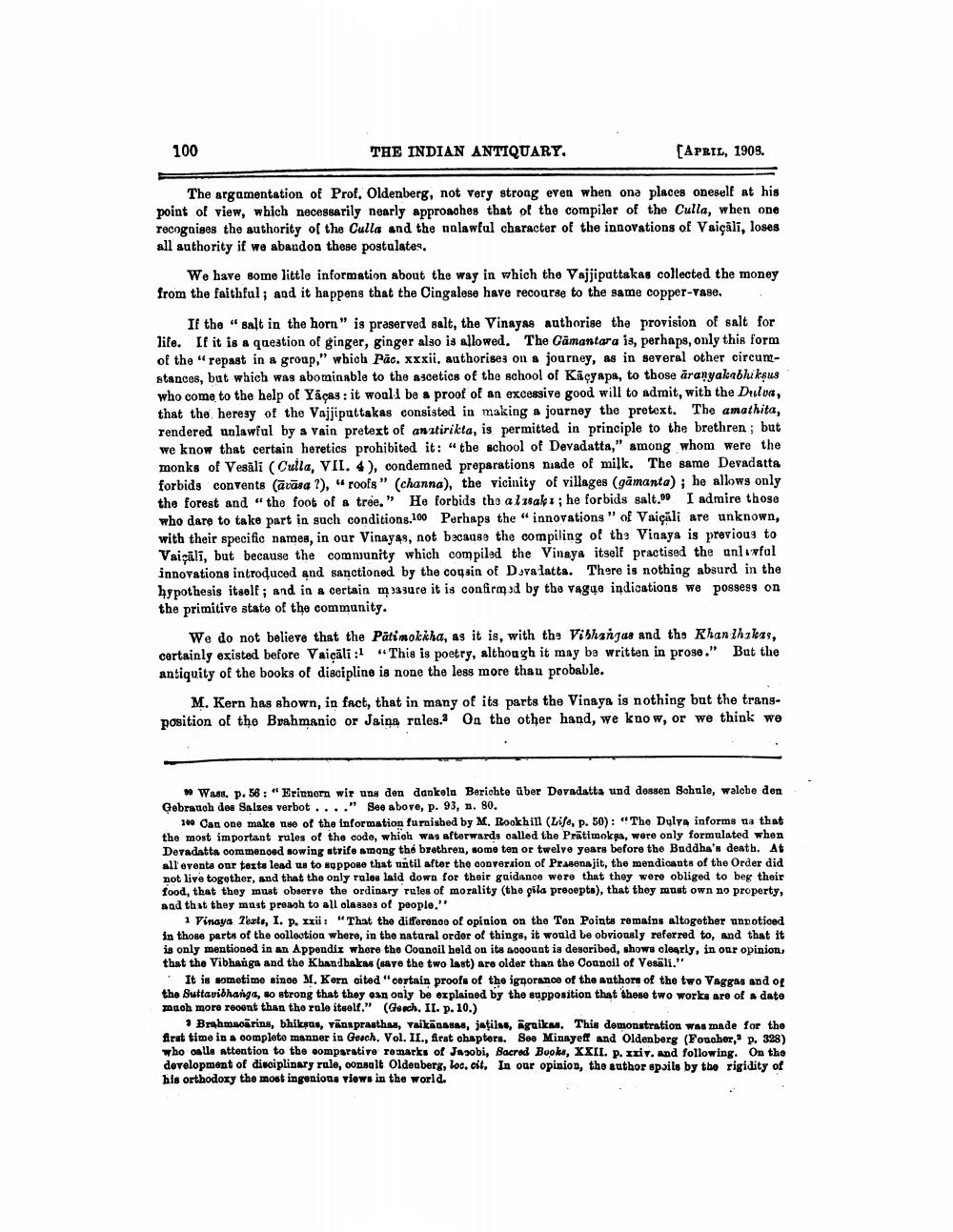________________
100
THE INDIAN ANTIQUARY.
[APRIL, 1908.
The argumentation of Prof. Oldenberg, not very strong even when one places oneself at his point of view, which necessarily nearly approaches that of the compiler of the Culla, when one recognises the authority of the Culla and the unlawful character of the innovations of Vaiçāli, loses all authority if we abandon these postulates.
We have some little information about the way in which the Vajjiputtakas collected the money from the faithful; and it happens that the Cingalese have recourse to the same copper-vase.
If the "salt in the horn" is preserved salt, the Vinayas authorise the provision of salt for life. If it is a question of ginger, ginger also is allowed. The Gamantara is, perhaps, only this form of the "repast in a group," which Pac. xxxii, authorises on a journey, as in several other circumstances, but which was abominable to the ascetics of the school of Kaçyapa, to those aranyakabhiksus who come to the help of Yaças: it would be a proof of an excessive good will to admit, with the Dulva, that the heresy of the Vajjiputtakas consisted in making a journey the pretext. The amathita, rendered unlawful by a vain pretext of anatirikta, is permitted in principle to the brethren; but we know that certain heretics prohibited it: "the school of Devadatta," among whom were the monks of Vesali (Culla, VII. 4), condemned preparations nade of milk. The same Devadatta forbids convents (avasa ?), "roofs" (channa), the vicinity of villages (gamanta); he allows only the forest and "the foot of a tree." He forbids the alisak; he forbids salt.99 I admire those who dare to take part in such conditions.100 Perhaps the "innovations" of Vaiçali are unknown, with their specific names, in our Vinayas, not because the compiling of the Vinaya is previous to Vaicālī, but because the community which compiled the Vinaya itself practised the anlwful innovations introduced and sanctioned by the cousin of Dovalatta. There is nothing absurd in the hypothesis itself; and in a certain measure it is confirmed by the vague indications we possess on the primitive state of the community.
We do not believe that the Pätimokkha, as it is, with the Vibhangas and the Khanthakas, certainly existed before Vaiçäli: "This is poetry, although it may be written in prose." But the antiquity of the books of discipline is none the less more than probable.
M. Kern has shown, in fact, that in many of its parts the Vinaya is nothing but the transposition of the Brahmanic or Jaina rales. On the other hand, we know, or we think we
Wass. p. 56: "Erinnern wir uns den dankela Berichte über Devadatta und dessen Schule, walche den Gebrauch des Salzes verbot...." See above, p. 93, n. 80.
100 Can one make use of the information furnished by M. Rookhill (Life, p. 50): "The Dulva informs us that the most important rules of the code, which was afterwards called the Pratimokga, were only formulated when Devadatta commenced sowing strife among the brethren, some ten or twelve years before the Buddha's death. At all events our texts lead us to suppose that until after the conversion of Prasenajit, the mendicants of the Order did not live together, and that the only rules laid down for their guidance were that they were obliged to beg their food, that they must observe the ordinary rules of morality (the gila precepts), that they must own no property, and that they must preach to all classes of people."
1 Vinaya Texts, I. p. xxii: "That the difference of opinion on the Ten Points remains altogether unnoticed in those parts of the collection where, in the natural order of things, it would be obviously referred to, and that it is only mentioned in an Appendix where the Council held on its account is described, shows clearly, in our opinion, that the Vibhanga and the Khandhakas (save the two last) are older than the Council of Vesali."
It is sometime since M. Kern cited "certain proofs of the ignorance of the authors of the two Vaggas and of the Suttavibhanga, so strong that they can only be explained by the supposition that these two works are of a date much more recent than the rule itself." (Gesch. II. p. 10.)
Brahmacarins, bhiksus, vanaprasthas, vaikanasas, jațilas, gaikas. This demonstration was made for the first time in a complete manner in Gesch. Vol. II., first chapters. See Minayeff and Oldenberg (Foucher, p. 328) who calls attention to the comparative remarks of Jacobi, Sacred Books, XXII. p. xxiv. and following. On the development of disciplinary rule, consult Oldenberg, loc. cit. In our opinion, the author spoils by the rigidity of his orthodoxy the most ingenious views in the world.




